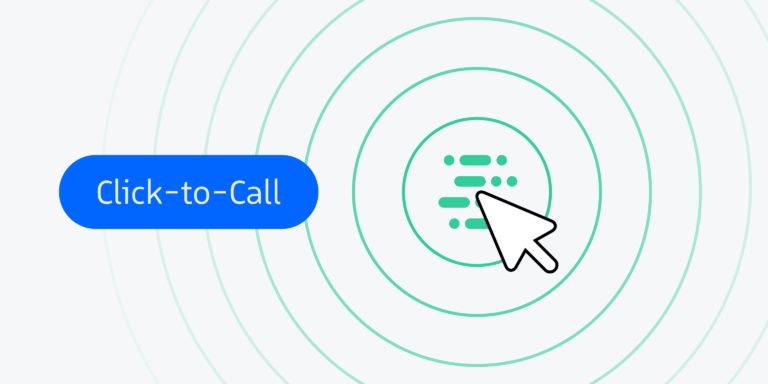
Enhancing Customer Engagement: The Power of Click-to-Call
- calltrack.ai
- No Comments
In today’s fast-paced business landscape, where instant communication is the norm, companies strive to connect with their audience seamlessly. Click-to-Call functionality has emerged as a powerful tool that bridges the gap between your brand and potential customers. Let’s delve into why click-to-call matters, how to implement it effectively, and the benefits it brings to your business.
Understanding Click-to-Call
What Is Click-to-Call?
At its core, Click-to-Call simplifies the process of connecting callers to their desired destination. Whether it’s a website visitor reaching out or a sales representative making outbound calls, click-to-call ensures immediate communication. Here’s how it works:
- User Interaction: When a user clicks on a designated link (often represented by a phone icon or text), the system initiates an outbound call.
- Seamless Connection: The call connects directly to the recipient’s phone app, eliminating manual dialing and streamlining communication.
Why Does Click-to-Call Matter?
1. Ease of Use for Consumers
- With one click, users can reach a live person at the other end of the line.
- No need for form submissions or waiting for return calls—click-to-call cuts to the chase immediately.
2. Enhanced Productivity
- Say goodbye to copy-pasting phone numbers or dealing with human error.
- Sales representatives can log better notes about callers in your CRM, improving call management.
3. Immediate Engagement
- Capture web traffic effectively by offering one-click dialing.
- Respond promptly to customer inquiries and engage with prospects without delay.
Implementing Click-to-Call on Your Website
Adding click-to-call buttons to your website is straightforward:
- Access Your HTML Editor:
- If you’re using WordPress, head to the Gutenberg Block Editor and click “Edit HTML.”
- For Shopify, navigate to “Online Store,” then “Themes,” and choose “Edit code.”
- In Squarespace, add a “Code Block” while editing a page or post.
- Insert the Link Tag:
- Use this standard link tag wherever you want the click-to-call button: <a href=””></a>.
- Insert your business phone number (without dashes) between the quotation marks: <a href=”tel:8882192787″></a>.
- Add “tel:” before the number: <a href=”tel:8882192787″></a>.
- Create a Call-to-Action (CTA):
- Enhance user understanding by adding anchor text: <a href=”tel:8882192787″>Call us at 888-219-2787</a>.
Benefits of Click-to-Call Buttons
- Consumer Convenience:
- Simplify communication for users—just one click connects them directly.
- Avoid frustrating experiences like waiting for return calls or navigating automated systems.
- Efficient Call Handling:
- Log better caller notes in your CRM.
- Accelerate workflows and improve conversion rates.
- Web Traffic Conversion:
- Make the most of website visitors by offering immediate dialing options.
- Stay responsive and engage with prospects promptly.
Remember that every brand and audience is unique, so consider A/B testing different CTA types and designs to find what works best for you.
By implementing click-to-call functionality, you’ll transform customer service, enhance marketing efforts, and ultimately drive more sales. So go ahead—give your website visitors and sales representatives the power to connect faster!
Best Practices for Successful Click-to-Call Implementation
Now that we’ve covered the basics of click-to-call, let’s dive deeper into best practices for successful implementation:
1. Strategically Place Your Buttons
- Consider user behavior and journey when deciding where to position click-to-call buttons.
- High-traffic pages (such as landing pages or product pages) are ideal spots.
- Ensure buttons are visible on mobile devices as well.
2. Design Matters
- Make your buttons stand out visually.
- Use contrasting colors or eye-catching icons.
- Test different button shapes (rectangular, circular) to see what resonates with your audience.
3. Optimize Loading Speed
- Slow-loading websites frustrate users.
- Optimize images and scripts to ensure quick loading times.
- Remember that impatient users may abandon your site if they encounter delays.
4. Track Performance Metrics
- Monitor click-through rates (CTR) for your click-to-call buttons.
- Analyze which pages or sections generate the most calls.
- Use tools like Google Analytics or call tracking software to gather insights.
5. Customize Caller Experience
- Personalize Greetings: When a user clicks to call, greet them by name if possible. Use dynamic placeholders to insert their name into the greeting.
- Route Calls Appropriately: Set up call routing rules based on the user’s location, language, or query type. Direct them to the most relevant department or agent.
- After-Hours Handling: If your business operates during specific hours, provide an after-hours message with alternative contact options.
6. Mobile Optimization
- Responsive Design: Ensure your click-to-call buttons work flawlessly on mobile devices. Test across various screen sizes and orientations.
- Thumb-Friendly Placement: Position buttons where users can easily tap them with their thumbs. The bottom of the screen is often more accessible.
7. A/B Testing
- Test Variations: Experiment with different button designs, colors, and placements.
- Analyze Metrics: Compare performance metrics (CTR, conversion rates) for each variation.
- Iterate Based on Data: Use insights to refine your click-to-call strategy continually.
8. Security and Privacy
- Secure Connections: Ensure that calls are encrypted and secure.
- Privacy Policies: Inform users about data collection during calls and adhere to privacy regulations (such as GDPR).
Dialing Up Success
Click-to-Call isn’t just about connecting calls; it’s about connecting people—your business with its audience. Embrace this technology, enhance customer engagement, and watch your growth soar!
